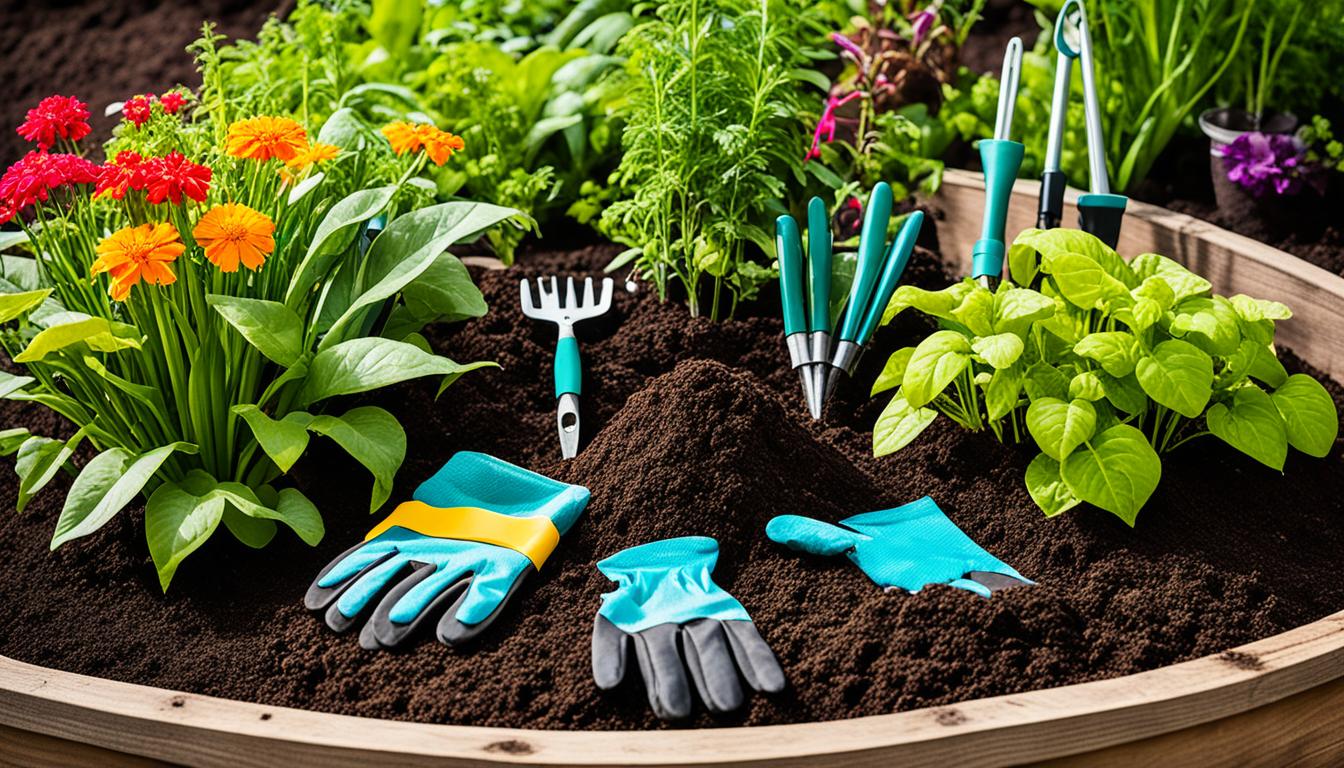As an avid gardener, I know the importance of starting with a solid foundation. That’s why crafting the perfect garden bed is essential for optimal plant growth. With a little DIY know-how and some careful planning, you can create a super soil that will nourish your plants and yield a bountiful harvest.
When it comes to crafting the perfect garden bed, it all starts with understanding your soil type and texture. Different soils have different needs, and by tailoring your soil amendments accordingly, you can create the ideal growing environment for your plants.
Adding organic matter, such as compost, coffee grounds, and shredded leaves, is key to improving the structure of your soil. It helps to promote drainage, aeration, and nutrient content – all crucial factors for plant health and growth. Taking the pH level of your soil into account is also important, as it can affect nutrient availability to your plants. Adjusting the pH level accordingly will help ensure that your plants can access the nutrients they need.
To maintain healthy soil in the long term, natural fertilizers and composting are essential. By incorporating these practices into your routine, you’ll be able to create and maintain the optimal soil conditions for your garden.
So, let’s roll up our sleeves and get started on crafting the perfect garden bed for optimal growth. With a little bit of time, effort, and the right ingredients, you’ll be well on your way to growing a lush, thriving garden that will be the envy of your neighbors.
Key Takeaways:
- Understanding your soil type and texture is crucial for crafting the perfect garden bed.
- Adding organic matter like compost and shredded leaves improves soil structure and nutrient content.
- Adjusting the pH level of your soil ensures optimal nutrient availability for your plants.
- Using natural fertilizers and composting helps maintain healthy soil in the long term.
- With the right ingredients and care, you can create a super soil that will support optimal plant growth.
Understanding Your Soil Type and Texture
The type and texture of your soil can significantly impact the growth and health of your plants. It’s essential to understand your soil’s characteristics to provide the right conditions for optimal plant development. Let’s explore different soil types and textures and learn how to improve them for successful organic gardening.
One common and desirable soil type for garden beds is loam. Loam soil contains a balanced mixture of sand, silt, and clay, which provides excellent drainage, moisture retention, and nutrient content. The crumbly texture of loam allows for easy root penetration and supports healthy plant growth.
However, not all gardeners are lucky to have loam soil. Sandy soils, for example, have larger particles and tend to drain quickly, making it challenging for plants to retain moisture and nutrients. On the other hand, clay soils have smaller particles that compact easily, leading to poor drainage and insufficient aeration.
To improve sandy soils, incorporating organic matter can help increase moisture retention and nutrient content. Adding compost, well-rotted manure, or leaf mold can enrich sandy soil with organic nutrients and improve its structure.
For clay soils, the goal is to promote better drainage and aeration. Mixing in organic matter, such as compost or well-rotted straw, can help break up the compacted clay and improve its texture. This amendment allows water to penetrate the soil more effectively and enhances root development.
Testing your soil type and texture is essential to determine the right steps to improve its nutrient content and structure. A soil test can provide valuable information about pH levels, nutrient deficiencies, and organic matter content. These insights enable you to tailor your soil amendments and gardening practices to meet your garden’s specific needs.
Key Points:
- Loam soil, with a balance of sand, silt, and clay, is ideal for garden beds.
- Sandy soils can be improved by adding organic matter to enhance moisture retention.
- Clay soils benefit from the addition of compost to improve drainage and aeration.
- Testing your soil type and texture helps determine the necessary steps for improvement.
Understanding your soil’s type and texture is the first step towards creating a successful organic garden. By implementing the right amendments and practices, you can improve soil health, promote nutrient-rich conditions, and provide your plants with the optimal environment for growth.
Importance of Organic Matter in Soil
When it comes to cultivating a healthy and thriving garden, incorporating organic matter into the soil is of utmost importance. Organic matter, such as compost, plays a vital role in improving soil health and creating an optimal environment for plant growth. By adding nutrient-rich materials to your soil, you can enhance nutrient retention, improve moisture levels, and promote the overall well-being of your garden.
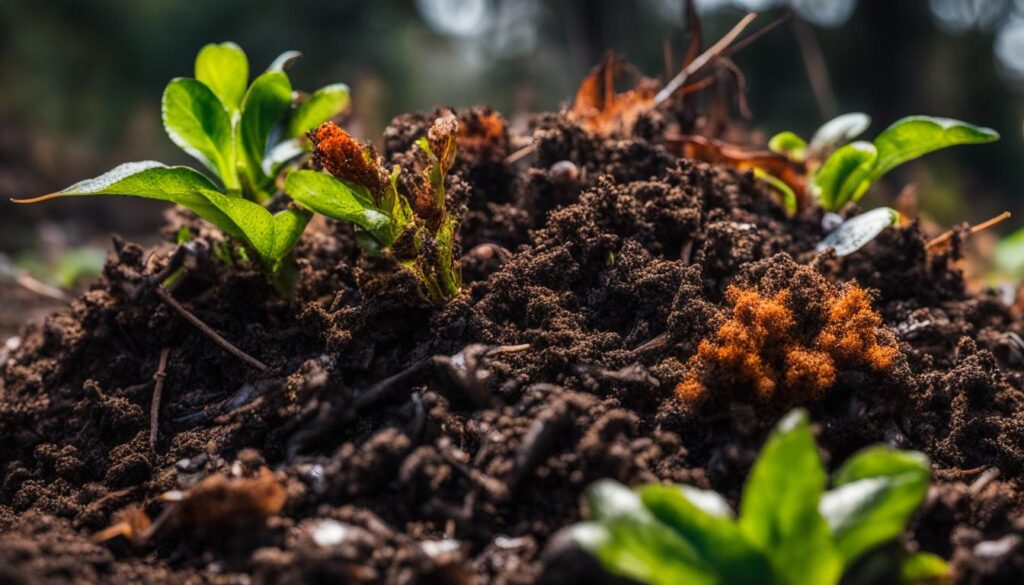
Compost, made from decomposed plant materials, is an excellent source of organic matter for your soil. It not only adds essential nutrients but also enhances soil structure and improves moisture retention. Additionally, compost stimulates beneficial microbial activity in the soil, fostering a healthy ecosystem for plants to thrive.
Aside from compost, there are other forms of organic matter that can contribute to the nutrient content of your soil. Coffee grounds, banana peels, and shredded leaves are all excellent options. These materials can be added to your compost pile or directly incorporated into the garden bed to nourish the soil and support healthy plant growth.
By incorporating organic matter into your soil, you are essentially feeding your plants from the ground up. It is an effective and natural way to enhance soil health, promote nutrient retention, and create an environment that fosters optimal growth. So, whether you choose to add compost, coffee grounds, or shredded leaves, remember that organic matter is the key to cultivating a thriving and bountiful garden.
The Role of Amendments in Soil Improvement
Soil amendments play a crucial role in enhancing soil quality, promoting aeration, and improving nutrient content. By incorporating these substances into the soil, we can create a healthier and more productive garden bed. Here are some key soil amendments that can help transform your soil:
Gypsum
Gypsum, a calcium-rich mineral, is an excellent amendment for compacted clay soil. Its ability to break up soil particles and improve water absorption makes it a valuable addition to any garden bed. Gypsum also enhances overall soil structure, allowing for better root penetration and nutrient uptake.
Molasses
Molasses is a natural and nutrient-rich substance that feeds beneficial microorganisms in the soil. Its high sugar content provides a food source for these microorganisms, promoting decomposition and nutrient recycling. By incorporating molasses into the soil, we can support the growth of healthy soil microbial communities and improve overall soil fertility.
Kelp
Kelp is a type of seaweed that offers numerous benefits as a soil amendment. Rich in essential minerals and trace elements, kelp provides valuable nutrients for plant growth. It promotes seed germination, enhances rooting, and increases disease resistance. Incorporating kelp into the soil can significantly improve the health and vitality of your garden plants.
Biochar
Biochar is a form of charcoal produced from organic matter that has been heated without oxygen. Adding biochar to the soil improves its structure, increases water and nutrient retention, and enhances microbial activity. It acts as a long-term carbon sink, contributing to climate change mitigation. Biochar is an excellent amendment for promoting soil health and nutrient availability.
By using these soil amendments strategically, we can transform our garden beds into nutrient-rich havens for plant growth. Whether you’re dealing with compacted clay soil, nutrient deficiencies, or poor soil structure, these amendments can help you achieve optimal soil conditions for healthy and thriving plants.
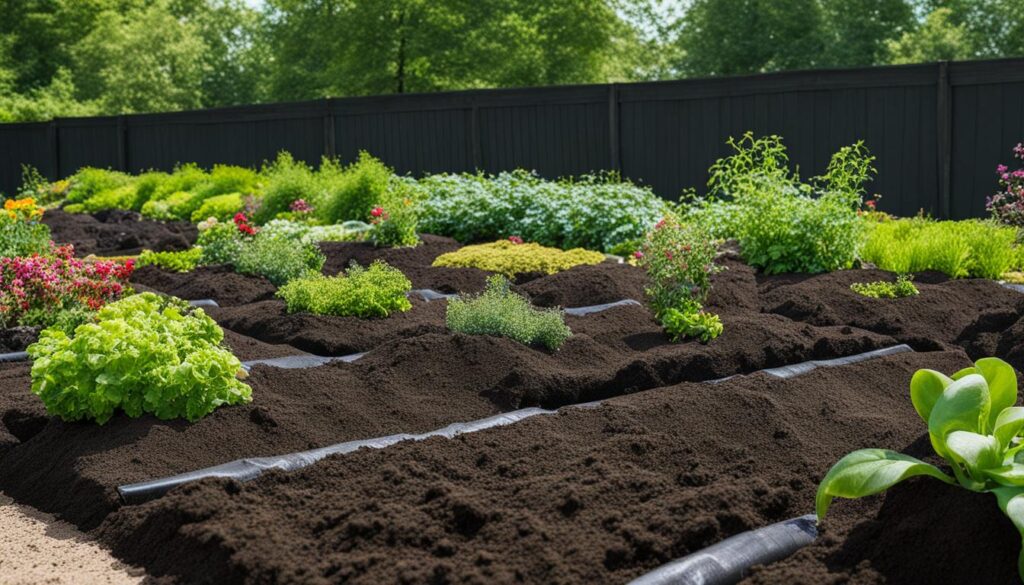
Creating the Best Organic Soil Mix for Vegetable Gardens
Determining the pH level of your soil is crucial for growing healthy vegetables. Most vegetables thrive in slightly acidic soil with a pH between 6.0 and 7.0. Adjusting the pH can be done by adding amendments like crushed limestone to make acidic soil more alkaline or peat moss to make alkaline soil more acidic.
Utilizing a mixture of topsoil, organic compost, and other organic materials like shredded leaves and worm castings creates a nutrient-rich organic soil mix that supports optimal vegetable growth. This organic soil mix provides the essential nutrients and beneficial microorganisms that vegetables need to grow strong and produce abundant yields.
Incorporating organic compost into the soil mix adds valuable organic matter, which enhances moisture retention and promotes nutrient availability. The compost also improves soil structure, allowing for better drainage and root penetration.
| Ingredients for the Best Organic Soil Mix |
|---|
| Topsoil |
| Organic compost |
| Shredded leaves |
| Worm castings |
These ingredients work together to create a balanced and fertile soil mixture suitable for vegetable gardens. They provide the necessary nutrients, improve soil structure, and promote healthy microbial activity in the soil.
When preparing your vegetable garden bed, ensure that you mix these ingredients thoroughly to achieve a consistent and well-blended organic soil mix. Spread the mixture evenly throughout the bed and gently work it into the existing soil. This will create a nutrient-rich growing environment that will support the development of healthy, productive vegetable plants.
Remember to regularly monitor the pH levels of your soil and make adjustments as necessary to provide the optimal growing conditions for your vegetables. By using this organic soil mix and maintaining proper soil amendments, you can create the best possible foundation for your vegetable garden and enjoy a bountiful harvest.
The Benefits of Raised Garden Beds
Raised garden beds are a popular choice among organic gardeners for several reasons. Not only do they provide a visually appealing structure to your garden, but they also offer numerous benefits for the health and productivity of your plants. Here are some of the key advantages of using raised garden beds:
Controlled Soil Quality
One of the primary benefits of raised garden beds is the ability to have complete control over your soil quality. By filling the raised beds with a carefully curated mix of organic raised bed soil, you can ensure that your plants have access to the optimal balance of nutrients for healthy growth. This control allows you to tailor the soil composition to the specific needs of the plants you intend to grow, maximizing their potential.
Improved Soil Structure and Drainage
Soil structure and drainage are crucial factors in promoting healthy plant growth. Raised garden beds provide excellent drainage due to their elevated design. Excess water drains away more efficiently, preventing waterlogged soil that can lead to root rot and other moisture-related issues. Additionally, raised garden beds allow for easier aeration of the soil, promoting a healthy root system and better overall plant health.
Reduced Risk of Compaction
Traditional in-ground gardening can lead to the compaction of soil over time, making it more difficult for plants to establish healthy root systems. Raised garden beds, on the other hand, are filled with loose, well-prepared soil. This loose soil structure is less prone to compaction, providing an ideal environment for roots to grow and expand. By reducing the risk of compaction, raised garden beds contribute to improved plant health and productivity.
Easier Plant Care and Harvesting
The elevated nature of raised garden beds offers the convenience of easy access to your plants, making it more comfortable to tend to their needs. Whether it’s watering, weeding, or harvesting, the raised height eliminates the need for bending or kneeling, reducing strain on your body. This accessibility also makes it easier to monitor your plants’ health and address any issues promptly.
When it comes to filling your raised garden beds, it’s essential to choose the right materials to create the optimal soil conditions. A combination of organic raised bed soil, such as Nature’s Care Organic Raised Bed Soil, organic compost, and other organic materials, will provide the perfect balance of nutrients, water retention, and aeration for your plants.
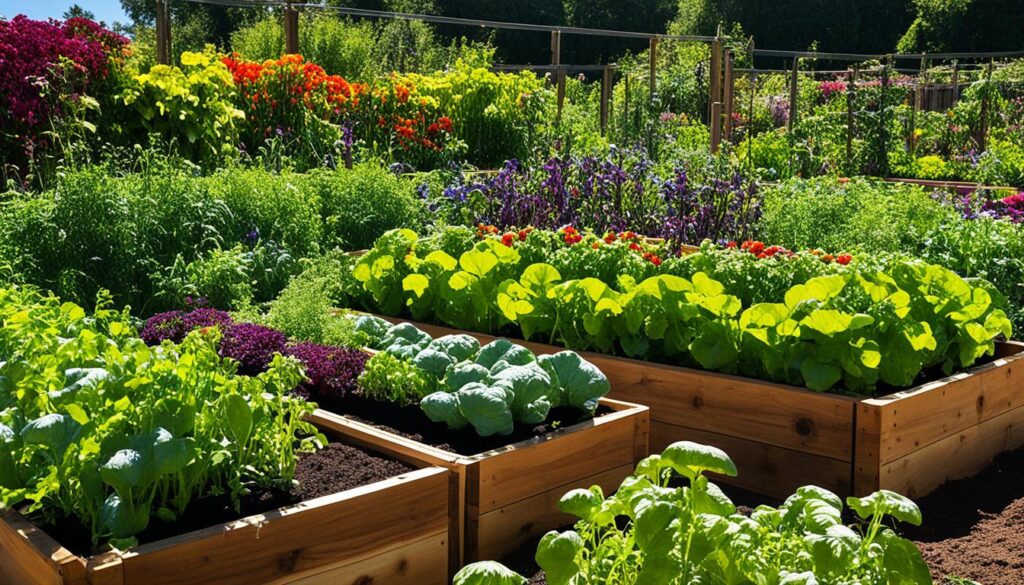
Cover Crops and Their Role in Soil Improvement
When it comes to improving the quality of your soil, cover crops are an excellent choice. Planting cover crops such as buckwheat, rye, barley, or clover in your garden can have multiple benefits for soil health and fertility.
These fast-growing annuals serve several purposes. Firstly, they help prevent erosion by covering the soil and protecting it from wind and rain. This is especially important during the off-season when your main crops are not growing. By keeping the soil covered, cover crops help retain moisture and prevent nutrient runoff.
One of the key advantages of cover crops is their ability to add organic matter to the soil. When you turn them under, they decompose and become part of the soil, enriching it with valuable nutrients. This process improves soil structure, enhances moisture retention, and encourages the growth of beneficial soil microorganisms.
Cover crops also play a crucial role in nitrogen fixation. Certain cover crops, like clover, have the ability to capture nitrogen from the atmosphere and convert it into a form that plants can easily absorb. This nitrogen fixation process naturally enhances the fertility of the soil, reducing the need for synthetic fertilizers.
To maximize the benefits of cover crops, it is recommended to implement a cover crop rotation plan. This involves sowing different cover crops at different times of the year, allowing each crop to contribute its unique set of benefits to the soil. By incorporating these cover crops into the soil, you can increase fertility, improve nutrient availability, and rejuvenate poor soil.
Example of Cover Crop Rotation Plan:
| Season | Cover Crop |
|---|---|
| Spring | Buckwheat |
| Summer | Sudangrass |
| Fall | Crimson Clover |
Implementing cover crops and a rotation plan can transform your soil, improving its structure, fertility, and overall health. By harnessing the power of these green companions, you can create a thriving ecosystem that supports the growth of healthy plants and maximizes your garden’s yield.
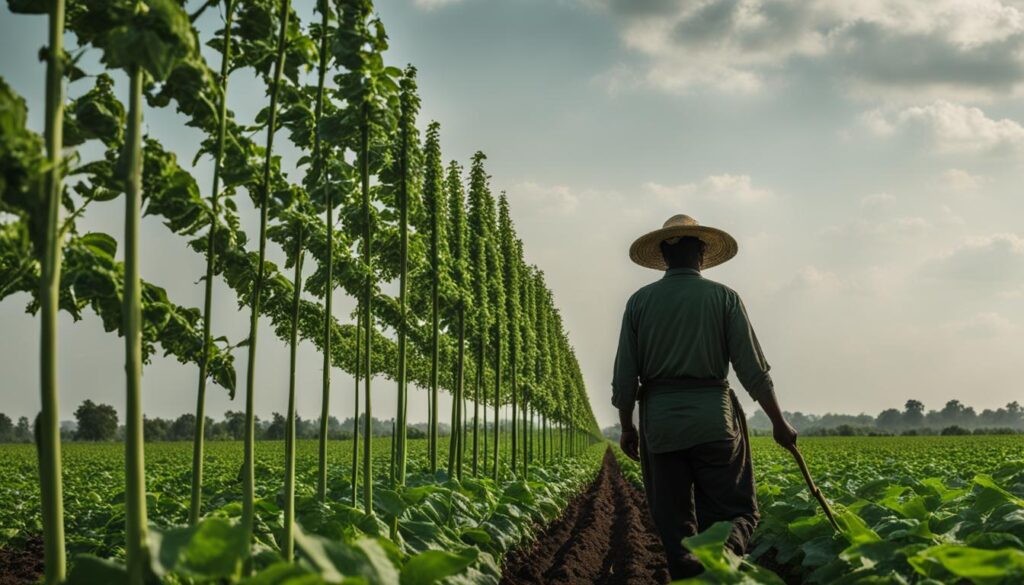
Double Digging for Improved Soil Structure
When it comes to creating the perfect garden bed, one technique that can significantly enhance soil structure is double digging. Although it may require some extra effort, the benefits it brings to your garden make it well worth considering.
Double digging is a labor-intensive practice that involves temporarily removing the topsoil to loosen hardpan and improve soil structure. By excavating rows and flipping the sod upside down at the bottom of the trench, you create better conditions for soil aeration and root penetration.
Allow me to guide you through the process of double digging:
- Start by marking out the area you wish to double dig. It’s essential to plan the width and length of your rows based on the size of your garden bed.
- Use a spade or garden fork to dig a trench along the first row, ideally about 12-18 inches deep. Set the excavated soil aside for the moment.
- Once the first trench is complete, take a garden fork and loosen the soil at the bottom, breaking up any compacted hardpan. This step is crucial for improving soil aeration and allowing roots to penetrate more easily.
- Next, proceed to the second row, using the soil from the first trench to fill in the trench of the second row. This process creates a continuous cycle of transferring soil from one row to the next.
- Continue this pattern until you complete the desired number of rows, making sure to mix organic matter, such as compost or aged manure, into the topsoil as you go.
- Finally, level the soil and smoothen the surface, ensuring that your garden bed is ready for planting.
It’s important to note that double digging is most effective when done in the early spring before planting. This timing allows the soil to settle and establish improved structure, ready to provide optimal conditions for your plants’ growth.
Double digging not only helps improve soil aeration and root penetration but also promotes better nutrient distribution and water absorption. By loosening the hardpan, you create a more hospitable environment for the roots to explore and gather nutrients for your plants’ optimal growth.
Double digging is like giving your soil a breath of fresh air, allowing roots to dig deeper and plants to thrive. It may require some extra effort, but the rewards are well worth it.
As a gardener, I encourage you to give double digging a try. Experience the difference it can make in providing your plants with the foundation they need for healthy growth and bountiful harvests.
In the next section, we will delve into the benefits of mulching and how it can further enhance your organic garden’s soil health.
The Benefits of Mulching
Mulching is a beneficial practice that plays a crucial role in maintaining soil health and promoting optimal plant growth. By applying a layer of organic mulch around plants, you can enjoy the following benefits:
- Soil Temperature Regulation: Mulch acts as a natural insulator, helping to regulate soil temperature. It keeps the soil warm during cold weather and cool during hot weather, creating a more favorable environment for plant roots.
- Moisture Retention: Mulch acts as a barrier, preventing excessive evaporation of moisture from the soil. It helps conserve water by reducing the need for frequent watering, especially during dry periods.
- Weed Control: An effective mulch layer suppresses weed growth by blocking sunlight and preventing weed seeds from sprouting. This reduces the competition for nutrients and water, allowing your plants to thrive.
- Improvement of Soil Health: Mulching promotes the decomposition of organic matter, enriching the soil with valuable nutrients over time. As the mulch breaks down, it improves soil structure and enhances microbial activity, which further benefits plant growth.
To mulch your garden, choose a natural and organic material that suits your needs and preferences. Popular options include wood chips, straw, leaves, grass clippings, and compost. Spread a layer of mulch around the base of plants, taking care not to pile it against the stems or trunks, as this can lead to rot or disease.
Tip: When mulching, aim for a thickness of 2-4 inches. Too thin, and the mulch may not provide adequate benefits; too thick, and it can create a barrier that prevents water from reaching the soil.
By incorporating mulching into your gardening routine, you can create a thriving and healthy garden bed that supports robust plant growth and minimizes maintenance tasks.
Conclusion
In conclusion, creating the perfect garden bed for optimal growth is the foundation of a successful organic garden. By understanding the soil type and texture of your garden, you can make informed decisions about the necessary amendments and soil preparation techniques.
Improving soil health through the addition of organic matter and amendments not only enhances nutrient availability but also boosts microbial activity, leading to healthier plants. Whether you choose to use raised garden beds, implement cover crops, or employ double-digging methods, the ultimate goal is to create a soil structure that supports root penetration, nutrient absorption, and overall plant health.
Consistently nurturing your garden soil by following these organic gardening practices will enable you to enjoy luscious, bountiful gardens and thriving plants. With the right soil conditions, optimal garden growth is within your reach, resulting in healthy and vibrant plant life.
FAQ
What are the key factors to consider when creating the perfect garden bed for optimal growth?
Understanding your soil type and texture, incorporating organic matter, using soil amendments, and proper soil preparation are essential for creating the perfect garden bed for optimal growth.
How can I determine the type and texture of my soil?
Testing the soil type and texture can be done through simple methods like feeling the texture, performing a jar test, or using commercially available soil testing kits.
What is the role of organic matter in soil?
Organic matter, such as compost, improves nutrient retention, adds moisture to the soil, enhances microbial activity, and supports overall soil health.
What are soil amendments, and how do they improve soil structure?
Soil amendments are substances added to the soil to improve its structure, aeration, and nutrient content. Examples include gypsum, which breaks up compacted clay soil, and biochar, which improves nutrient retention and overall soil health.
How do I create the best organic soil mix for vegetable gardens?
Creating the best organic soil mix involves incorporating topsoil, organic compost, and other organic materials while considering the pH levels and incorporating suitable soil amendments.
What are the benefits of raised garden beds?
Raised garden beds provide controlled soil quality, improved drainage, reduced risk of compaction, and easier access for plant care and maintenance.
How can cover crops help improve soil quality?
Cover crops, such as buckwheat, rye, barley, or clover, prevent erosion, add organic matter when turned under, and fix atmospheric nitrogen into the soil, thereby improving soil quality.
How does double digging contribute to improved soil structure?
Double digging involves loosening hardpan and enhancing soil structure by aerating the soil and creating better conditions for plant roots to penetrate.
What are the benefits of mulching?
Mulching regulates soil temperature, retains moisture, controls weeds, improves overall soil health, and promotes the decomposition of organic matter, adding nutrients to the soil.
What are the key takeaways for achieving optimal garden growth?
Understanding your soil, incorporating organic matter, using soil amendments, creating the right soil mix, utilizing raised garden beds, cover crops, double digging, and mulching are all essential practices for achieving optimal garden growth and maintaining healthy plants.

